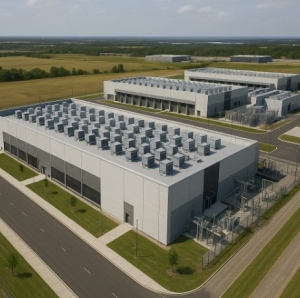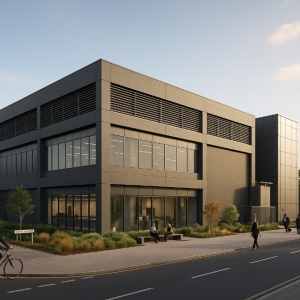In late September, outline planning was secured for a £1.3 billion AI data centre in Essex. The plans are vast: 27,000 m² of data halls, a 4,500 m² substation, new cabling infrastructure, and seven years of phased development. Beyond the construction, the real spend will be in the fit-out. Industry estimates suggest around £500 million in hardware, networking, and high-density cabling could be installed before completion.
And this is no longer unusual. Barely a week goes by without another announcement of a hyperscale data centre in the UK or Europe. From Teesworks in the North East to clusters around Dublin, Frankfurt, and Amsterdam, the data centre build rate has accelerated faster than ever before.
So what is driving this boom, and how is it reshaping the cabling and engineering industries that support it?
Why so many, why so fast?
The surge in data centre projects comes from a perfect storm of demand drivers:
- Artificial Intelligence and compute hunger: Training and running large models requires entire halls of GPU clusters and high-performance networking.
- Cloud adoption: Enterprises are still migrating workloads into AWS, Microsoft Azure, and Google Cloud, and demand has not peaked.
- Latency and edge computing: New services like AR, VR, and autonomous systems require distributed but powerful hubs close to users.
- Investor appetite: Data centres are now seen as critical infrastructure, attracting billions in capital from pension funds and global asset managers.
- Government support: The UK has designated AI Growth Zones, and EU states are fast-tracking permits for strategic digital infrastructure.
The Essex project itself highlights these dynamics. It includes a nature reserve buffer of 34.5 acres to address community concerns, alongside a closed-loop water cooling system to reduce environmental impact. These are no longer just “warehouses for servers” but high-profile infrastructure builds designed to meet demanding digital and sustainability requirements.
The scale of the build
To put the Essex scheme in perspective:
- Seven-year phasing: a long pipeline of jobs for contractors, subcontractors and suppliers.
- Dedicated power infrastructure: its own substation and high-voltage connections into the national grid.
- Hardware spend: likely exceeding £500 million on servers, storage, networking and structured cabling over the project lifetime.
- Specialist systems: UPS, cooling, generators, fire suppression, containment, fibre backbones, and resilience measures for Tier-3 and Tier-4 standards.
Each of these elements requires large numbers of specialists, from cabling engineers and electricians to commissioning managers and project leaders.
A new career and industry pivot
Perhaps the most striking effect of the boom is the shift in people and companies moving into the sector. For decades, structured cabling and commercial contractors built their reputations in offices, universities, airports and retail roll-outs. Today, the future is in hyperscale and AI data centres.
We are seeing:
- Structured cabling specialists retraining into fibre, containment and high-density patching designed for hyperscale loads.
- Commercial contractors moving into Tier-3 and Tier-4 critical environment experience where uptime is non-negotiable.
- Project managers who once ran retail or university builds rebranding as data centre delivery specialists, managing complex multi-phase programmes.
- Electrical contractors diversifying into high-voltage and UPS systems, often delivered alongside structured cabling packages.
- Large data cabling companies, once focused almost exclusively on industrial and commercial projects, are now building dedicated critical-infrastructure divisions to compete for hyperscale data centre tenders.
The ripple effect is significant. Skills once seen as niche, such as fibre splicing, containment installation, and testing and inspection of high-density cabling, are now in hot demand.
Opportunities and challenges
The boom has created vast opportunities for those in the supply chain, but also a new set of challenges:
- Workforce shortages: demand for data cabling engineers, project managers and commissioning specialists far outstrips supply.
- Training and standards: engineers need to upskill quickly to meet Tier-3 and Tier-4 standards with new health, safety and compliance regimes.
- Environmental scrutiny: cooling methods, water usage and energy efficiency are now deal-breakers for planners and investors.
- Power bottlenecks: without grid upgrades, many projects risk stalling or scaling back.
- Heat reuse and sustainability: the industry is under pressure to capture and reuse waste heat rather than let it dissipate.
What it means for the future
For those in data cabling and structured cabling, this is a once-in-a-generation shift. The work has moved beyond traditional commercial installs into critical national infrastructure with budgets, risks and standards to match.
For clients and investors, the trend suggests that the UK and Europe will continue to see mega-data centre approvals almost weekly. The only real brake may come from power availability and planning resistance.
For now, the trajectory is clear: another week, another mega-data centre. With each new approval, the opportunities for engineers, contractors and cabling specialists continue to expand.
Final thought
The Essex scheme is just the latest example in a wave that shows no sign of slowing. With half a billion pounds in hardware fit-out alone and billions more in construction, these projects are becoming the new normal. For individuals and companies willing to pivot from commercial cabling to data centre specialism, the rewards are already here.
The question is not whether the boom will continue, but how the industry will adapt fast enough to keep pace.
The rumoured plans for Google to establish a massive new AI data centre at the Teesworks site in North East England encapsulate not just the exciting potential of advanced technological development, but also the complex dance of industrial interests and regional planning. Teesworks, a sprawling former steelworks site, is currently a stage for competing visions of the future: on one side, an AI-driven technological hub potentially spearheaded by one of the world’s most powerful tech companies, and on the other, a major new hydrogen production facility proposed by BP.
The interest from Google in setting up an AI data centre could be transformative for the region. The local economy would likely see a significant uptick in construction jobs in the short term and more specialised roles in data management, structured cabling installation, and IT infrastructure upon completion. Furthermore, with the government designating Teesworks as an AI Growth Zone, the site's future as a nexus for technology and innovation seems promising. However, if Google finalises its presence on the site, it will require vast amounts of data cabling and a highly skilled workforce of data centre engineers to manage the complex technology infrastructure. Once work starts, there will undoubtedly be a struggle for labour, as such a development could become one of the largest infrastructure builds in the region. Much like the recent data centre project in Corsham, contractors may need to be sourced from outside the local area, with demand for digs, hotels, and Airbnbs rising sharply as the workforce is mobilised.
When could work start?
Although nothing has been confirmed, the likely timeline is beginning to take shape. A planning application for a 500,000 sqm facility at Teesworks was submitted in June 2025, and reports suggest negotiations with Google could be concluded before Christmas 2025. If that agreement is reached, 2026 would likely see detailed planning approvals, procurement, site preparation, and early infrastructure work. Major construction activity could realistically begin in late 2026 or early 2027, with phased completion and commissioning of data halls stretching into 2028 and beyond. This means the region’s construction, engineering, and data cabling workforce needs to prepare now, as competition for skilled labour will intensify once the project breaks ground.
Despite these enticing prospects, the ongoing negotiations highlight a broader conflict within sectors of the government and between major corporate entities. The tug-of-war between the supporters of the AI data centre and proponents of BP's blue-hydrogen plant illustrates the challenges that come with managing a site with such vast potential. The decisions made here will have long-term implications on the UK's industrial strategy and its ability to compete globally in both technology and energy sectors. Additionally, if BP's plan does not receive approval and they choose to contest the decision, the resultant delays could hinder progress not only for Teesworks but for broader industrial advancement in the UK.
This complex scenario underscores the critical need for skilled professionals in the construction, engineering, structured cabling, and data centre sectors. Recruitment within these areas must anticipate the need for a workforce capable of adapting to the rapidly evolving demands of both the renewable energy and technology markets. As regions like Teesworks look towards future-proof industries, the role of specialised recruitment and workforce development can’t be overstated. Data centre engineers, structured cabling specialists, and IT infrastructure professionals should watch these developments closely, as the outcomes will likely influence job opportunities and sector growth for years to come.
In conclusion, Google's potential establishment of an AI data centre at Teesworks marks a significant moment in UK industrial planning. Whether or not Google’s plans will come to fruition remains to be seen, but one thing is clear: the UK's construction, data cabling, and technology sectors need to prepare to adapt to the evolving landscape of infrastructure that such large-scale projects will demand. Ensuring that the workforce is ready to meet these challenges will be paramount for tapping into the economic opportunities that such developments bring.
The UK's data centre sector is on the verge of a significant transformation, thanks to major new investments like the £500 million spearheaded by BlackRock in collaboration with Digital Gravity Partners. This move not only reaffirms the UK's position as a vibrant hub for technological advancements but also indicates a substantial increase in need for skilled construction professionals and data cabling experts. The planned upgrade and expansion of existing facilities are poised to create a plethora of job opportunities.
The timing of these investments coincides with high-profile events and the attendance of industry giants such as Larry Fink of BlackRock and tech leaders like Jensen Huang from Nvidia, signalling a robust confidence in the UK's market. Such endorsements are particularly significant when one considers the backdrop of President Trump’s controversial state visit. Despite potential political discord, the focus remains firmly on the economic prospects these investments will unleash, particularly in the technology and construction sectors.
Furthermore, the innovative approach of using small modular reactors for powering data centres, as outlined by Holtec's recent announcement to develop at Nottinghamshire's former Cottam coal station, adds another layer of excitement and opportunity. This not only highlights a push towards more sustainable practices but also foreshadows the evolving skill sets that will be required in the construction industry. Thus, it pushes for an urgent need to groom or recruit talent equipped with modern technological know-how alongside traditional construction skills.
In light of these developments, it is clear that professionals in the construction and data cabling domains should keenly observe the evolving landscape. Recruitment agencies and construction firms must be proactive in preparing a workforce that can meet the demands of these sophisticated infrastructures. Training in AI, sustainable construction practices, and data centre specifications will be particularly valuable. This ensures not only the ability to participate in upcoming projects but also the capacity to lead in an industry on the brink of a major technological leap forward.
As the UK gears up to display formidable investment figures and job creation stats, positioning itself as a prime player open for business post-Brexit, the ripple effects on employment, specifically in construction and data infrastructure, will be significant. For those in the recruitment sector, staying ahead of the curve by understanding these investments and readying a qualified workforce will be key to leveraging the anticipated boom in the UK's data centre expansion.
At Bauhaus Recruitment, we pride ourselves on supplying highly skilled engineers across the UK and Europe to support mission-critical data centre projects. Our clients rely on us to provide trusted local resource that can be deployed quickly, ensuring technical work is delivered to the highest standard while meeting strict project deadlines.
Supporting a Data Centre Project in the Netherlands
One recent example saw our engineers deployed to a hyperscale data centre site in the Netherlands, tasked with commissioning and verifying complex CCTV systems. Security infrastructure is a cornerstone of any modern data centre, and precision at this stage is vital to ensure both compliance and long-term reliability.
Key responsibilities included:
- Commissioning CCTV systems to ensure full operational readiness
- Validating Field of View (FOV) across all cameras to guarantee correct coverage and eliminate blind spots
- Documenting associated IP addresses and maintaining accurate records for seamless handover to the client’s operations team
Our engineers combined technical knowledge with attention to detail, ensuring every camera was positioned, tested, and logged correctly. This documentation not only supports ongoing operations but also provides the client with a clear audit trail for future reference.
Why Local Resource and Compliance Matter
Deploying local EU-passport engineers meant the client avoided costly delays and logistical challenges often associated with cross-border projects. Beyond just supply, Bauhaus ensured all activity was compliant by working with specialist partners to apply local tax and social security requirements. This gave the client peace of mind that their project was fully above board and aligned with Dutch employment regulations.
The Bauhaus Advantage
This project reflects Bauhaus’s wider capability:
- Specialist talent pool across data cabling, security, and commissioning disciplines
- Experience working on hyperscale and enterprise-level data centres across the UK and mainland Europe
- Compliance built-in through applying local tax via expert partners, ensuring clients face no regulatory risk
- Commitment to delivery with engineers who can adapt quickly and complete projects to the highest standards
By partnering with Bauhaus, clients can be confident their projects are supported by engineers with the right technical skills, deployed compliantly and efficiently across Europe.
HE Simm files administration notice
HE Simm, a family-run M&E contractor employing around 184 people, has filed a notice of intention to appoint administrators. The company, founded more than 75 years ago, blamed heavy losses on inflationary pressures tied to fixed-price contracts and performance issues on several legacy projects in London.
The collapse is another reminder of how fragile the sector can be under current conditions. While the headlines focus on the main contractor, the ripple effects are felt across the supply chain. Many structured cabling and data cabling firms depend on M&E companies for projects, meaning engineers, subcontractors and suppliers are left dealing with the uncertainty.
At Bauhaus Recruitment, our thoughts are with those affected. If you’re an engineer or contractor caught up in this situation, please reach out — we have opportunities across data centres, cabling and technical projects.
#Construction #M&E #DataCentres #StructuredCabling #Engineering
The recently approved plan for a new data centre in Hemel Hempstead marks a significant advancement in the UK’s digital infrastructure, particularly in an era where data handling and storage are increasingly crucial. Positioned to replace an older warehouse and office facility, this project not only enhances the digital capabilities of the region but also transforms the existing workplace environment.
Designed by Scott Brownrigg for Northtree Investment Management, the new data centre will be a three-storey structure, offering approximately 5,000 square metres of space. It is not just about scale; the strategic location at 45 Marylands Avenue will integrate essential support functions including office spaces and a substation, alongside provisions for car parking and servicing areas. This reflects a comprehensive approach to the data centre’s functionality and accessibility.
In addition to operational efficiency, the design plan embraces public realm improvements. The aim is to strengthen the boulevard’s character through a generous setback and to enhance pedestrian and cycle routes with new landscaping and seating areas. This focus on aesthetic and functional improvements highlights a wider trend where data centres are increasingly designed to integrate with their immediate surroundings.
Hemel Hempstead’s growing prominence as a hub in the data centre cluster, paralleling established areas such as Slough and Stockley Park, reflects a strategic push towards optimising regions with close proximity to London but greater availability of land and resources. The need for such infrastructure is underscored by past challenges in nearby areas where proposals for similar developments faced administrative hurdles, further emphasising the pressing demand for increased data centre capacity.
The architectural and planning vision involves more than aesthetic appeal and basic utility. Scott Brownrigg’s proposal incorporates sustainable design principles. A ‘fabric-first’ approach ensures the building itself contributes significantly to energy efficiency, leveraging natural ventilation and the strategic planting of local flora to support biodiversity while delivering visual and environmental benefits.
In terms of employment and local economic impact, the development of this data centre is expected to deliver a dual benefit. In the short term, the construction phase will create roles ranging from builders to electrical and data cabling specialists. Longer term, the operational phase will sustain demand for a skilled workforce to manage, maintain and secure the facility. This creates ongoing opportunities for employment across multiple disciplines.
For professionals in the construction, recruitment and data cabling sectors, such projects highlight the strong demand for skilled labour while also underscoring the way digital infrastructure is becoming integral to urban planning and economic development. The new data centre in Hemel Hempstead therefore represents not only an advance in digital capability but also a boost for employment and local growth.
Ultimately, the evolution of data centres such as this one reflects a broader trend: as reliance on digital services grows, so too does the complexity and necessity of the supporting infrastructure. For industry professionals, staying informed and adaptable to these changes is not merely beneficial, it is essential to thrive in the rapidly evolving landscape of construction and digital infrastructure.








